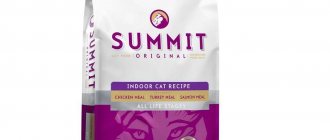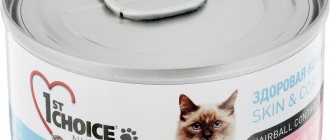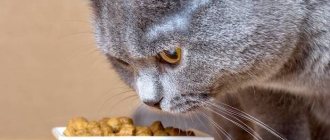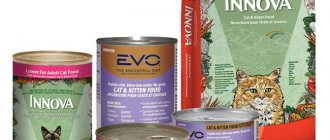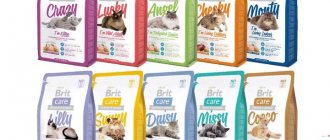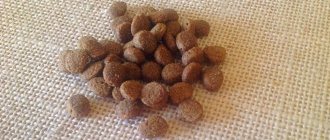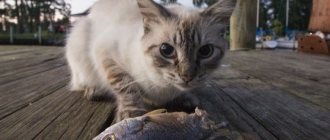What does a cat need?
Cats are obligate carnivores, meaning their diet consists primarily of meat. Pets need animal proteins and amino acids more than carbohydrates. They need connections not only to obtain energy, but also to ensure the correct functioning of all organs and systems.
In their natural environment, animals hunt small game: rodents, birds, etc. From the stomachs of the victims, cats obtain a small amount of cereals, vegetables and fruits. Products in the gastrointestinal tract of birds and rodents are subject to primary processing with enzymes. In this form, they are relatively well absorbed by the cat’s body, but most of the beneficial substances still leave the intestines unchanged. The resulting plant food helps satisfy the daily need for those microelements that are not found in meat.
When eating natural products, 75–80% of the menu is meat, 10–15% is allocated to offal and 10% is reserved for fermented milk products and vegetables
Like all living beings, a cat needs water, so it is advisable to give it not only dry, but also wet food. The granulated product contains practically no liquid, which can become an additional risk factor if the drinking regime is not followed. Dehydration can lead to problems with the gastrointestinal tract, kidneys, cardiovascular system and other organs. In some cases, wet food is the only acceptable option. For example, my cat has very sensitive digestion: after eating granules, she has blood in her stool. After the examination, the veterinarian said that this is an individual feature, in general the animal is healthy, but it is better to switch to pouches and pates. Hard granules damage the delicate internal lining, which can later cause inflammation and infection. The cat does not have such a reaction to wet food.
There is starch, but no flour and soy
Another fear of animal owners is that wet food contains starch, soy, and thickeners. There is indeed starch in food, but not all (details in product cards). There is no starch in Purina, Royal Canin, Sheba, Nature's table, Brit and Schesir foods.
All feeds do not contain, judging by the examination data, the thickener carrageenan and guar and carob gum, peas, soy concentrate, textured soy protein product, fermented rice, flour, isolated soy protein.
What should be in cat food
High-quality cat food should primarily contain meat. The presence of several varieties is welcome if the pet does not have problems with food intolerance. The use of different types of animal products allows you to provide the cat’s body with all the necessary amino acids and trace elements. It’s good if the manufacturer indicated that the composition includes fresh meat. This means that it was not subjected to preliminary heat treatment and long-term storage. However, it should be taken into account that fresh meat also includes a large amount of liquid (about 70–80%), which in the case of low-quality dry food with fillers distorts the overall picture.
Fish contains a lot of unsaturated fatty acids, so its presence in the composition is a significant advantage, but for castrated animals it is better to choose a different food: a high concentration of minerals provokes the development of urolithiasis
Dehydrated meat is almost as good as fresh meat, and in some cases it is even better. When a dried ingredient appears first in a grain food, it lets the consumer know that the diet contains enough amino acids. Of course, grain-free food is preferable, but owners do not always have the opportunity to give their pets such products. For example, my friend’s cat developed nausea and vomiting when transferring from economy class to holistic.
Whole carcasses without by-products (“chicken”, “turkey”, “duck”) are also an acceptable ingredient. Internal organs are removed during the preparation of raw materials, leaving only meat and skin. Sometimes, along with carcasses, a small proportion of cartilage, bones and other impurities enters the feed, but in the case of high-quality products this is even useful: a small amount of offal is included in the natural menu and helps meet the daily needs for microelements. If we are talking about budget rations, the situation may be worse. Unscrupulous producers may process carcasses less carefully or introduce additives, so the quality of the ingredient depends on the feed manufacturer.
Beef tripe is a healthy by-product: it contains probiotics and enzymes, therefore improves digestion
Vegetables, fruits, berries, herbs, plant extracts, etc. can be included in the food as a vitamin-mineral complex. In small quantities, they help obtain microelements that are better absorbed in their natural form. Additionally, plant components contain fiber. It stimulates the movement of feces, improves peristalsis and cleanses the mucous membranes of the gastrointestinal tract from rotting food debris. Many such supplements also promote the normal development of microflora, creating an optimal environment for the growth of beneficial bacteria. This prevents food from rotting and increases resistance to infections.
Some cat foods (Pronature, 1st Choice) contain ginger: it improves immunity and has a general strengthening effect
The presence of preventive additives in the feed is encouraged. With the right choice of complex, nutrition will prevent the appearance of age-related problems and the development of certain pathologies. For example, berries and many fruits normalize the acidity of urine, which prevents the formation of stones in the urinary system. Cartilage is a natural source of glucosamine and chondroitin, which are essential for maintaining musculoskeletal health. Clams, crab shells and some other analogues can replace this ingredient. Beans in small quantities improve digestion.
Any food must contain preservatives. In the case of high-quality products, rosemary and a mixture of tocopherols are used to reliably preserve them. The combination of these two components prevents early spoilage and is not harmful to health.
The broth is a natural flavoring additive: the liquid is sprayed onto the granules at the end of cooking
To increase taste and aroma appeal, manufacturers can include natural additives in the composition. For example, chicken liver. Such additives are safe in most cases, although if possible, it is advisable to familiarize yourself with a detailed analysis of the composition. Increasing the attractiveness of food is necessary if the pet has health problems that are accompanied by a deterioration in appetite. This will also help to “agree” with finicky animals. The presence of flavoring and aromatic additives makes the transition to a new food easier.
About products
The rating of wet food for adult cats includes 20 TM products. These are economy and premium segment food produced in Russia (16 TM), Czech Republic (1 TM), France (2 TM) and Thailand (1 TM). The list included wet food in three formats: pate, pieces in jelly and pieces in sauce. The moisture content of these feeds varies from 76 to 85%. None of the goods are produced according to GOST. The goods are manufactured according to our own technical specifications (TS) or other regulatory documents. Feeds 15 TM are declared as complete rations, one is intended for an additional diet, on four feeds there is no message about completeness/non-completeness.
Of these foods, 19 are intended for healthy cats that do not have any pathologies, one is intended for dietary nutrition. This food was taken into the sample for the purpose of comparison; in the future, Roskachestvo will study other food in this category. An analysis of wet cat food showed that even the special purpose of the food does not guarantee the buyer the authenticity of the labeling. Details in product cards.
Package weight – from 85 to 415 g. Purchase cost – from 7 to 160 rubles per 100 g.
Previously, Roskachestvo examined dry cat food. Details HERE
.
The food tested was poultry flavored, namely chicken (2), as it is the most popular. This was confirmed by the results of a survey of visitors to our portals and social networks. Poultry food (chicken, turkey, etc.) is purchased by 71% of respondents. We thank everyone who takes part in Roskachestvo surveys!
Russian quality system standard
The standard of the Russian quality system for wet food (for cats), applying for the Russian Quality Mark, has established advanced requirements for the amount of dry matter, mass fraction of protein, moisture (at least 60%), raw ash, calcium, fiber and phosphorus, as well as acid and peroxide number of fat. The standard sets standards for the content of amino acids, vitamins and microelements. According to the standard, preservatives (sorbic and benzoic acids) and dyes are not allowed in cat food.
The testing program additionally included determination of the content of histamine, GMOs, antibiotics and pesticides in feed.
Products that comply with the standards specified in the STO have the right to apply for the Russian Quality Mark. The level of localization of production for the assignment of the Russian Quality Mark must be at least 70% of the cost of the product.
The requirements of the Roskachestvo standard are voluntary and are not mandatory for the manufacturer. If the product meets the advanced requirements of the Roskachestvo standard, the manufacturer receives the right to apply for product labeling with the Russian Quality Mark.
What shouldn't be in cat food
In a good food, the proportion of grains should be kept to a minimum, up to the complete absence of grains in the composition. This component is practically not absorbed by cats. Its main task is to provide the animal’s body with carbohydrates and fiber. Vegetables and fruits, which have greater nutritional value, cope better with this. Cereals are often used as a cheap filler. The most dangerous of them are corn and wheat. They often cause the development of allergies. The presence of barley and oats is more acceptable, however, their share should be minimal.
Sometimes manufacturers replace grains with beans or potatoes, but in reality this makes little difference: cats need meat more than plant ingredients
The presence of any common names is not welcome. This applies to both animal and plant components. The presence of vague concepts in the list of ingredients indicates either the low quality of the raw materials (i.e., the manufacturer is hiding something) or the instability of the composition. In the latter case, the manufacturing company retains the ability to use different components in each batch. This does not correspond to the biological needs of cats: in the wild, the chemical composition of game remains almost the same. Frequent menu changes contribute to digestive disorders.
Some of the most common unwanted components include the following:
- Bird. It may turn out to be either chicken or turkey. The first is, of course, more likely. The definition of “poultry” does not characterize the ingredient, since the manufacturer does not specify what exactly the food contains: meat, internal organs, skin or something else. In most cases, the name “poultry” hides cheap by-products that have no nutritional value.
- Meat. An even more vague component than “bird”. This can equally well include chicken, beef, pork and even fish. In most cases, the manufacturer uses low-quality components. If an allergy occurs, it will be difficult for the pet owner to understand what caused the problem.
- Fish. The disadvantages are the same as those of the above ingredients.
- Animal fat. Of course, it is commendable that the manufacturer does not use only vegetable oils, but the source of the component must be indicated.
- Cereals. Any variety can be hidden under this name. Most often, manufacturers try to hide the presence of corn and wheat in the composition using a common name.
- Vegetables. The ingredient is often mentioned by unscrupulous companies. This marketing ploy is designed for inexperienced buyers: many people will think that the presence of vegetables in the composition is a huge plus, because they contain useful substances. In reality, manufacturers usually do not use whole luxury products, but rather individual parts. For example, partitions. In addition, carnivores do not absorb nutrients from vegetables well, so there is no need for large amounts of plant ingredients. It is preferable to indicate specific varieties.
- Offal. A component can be either beneficial or harmful depending on the composition of the mixture. If a manufacturer doesn't specify a specific type of ingredient, they likely have something to hide.
- Processed products. In other words, industrial waste. For the sake of economy, those components that remain after the production of other products are added to the feed. In the case of ingredients of animal origin, this may be so-called pink slime. It remains after cutting the carcasses. If these are products of processing of plant components, then the manufacturer probably means peeling, peeling, etc.
The presence of vitamins, minerals and amino acids in dry food in their pure form is not recommended. Ideally, the diet should be as close as possible to the natural menu, not only in chemical composition, but also in content. Animals absorb certain supplements less well than the same beneficial substances from whole ingredients. In addition, the presence of amino acids indicates a lack of meat in the feed. In a cat's natural environment, the same taurine is obtained from animal products.
In general, there is nothing dangerous in the above ingredients, but there is also little useful in them. This becomes the reason for the development of pathologies when feeding economy and premium products. Due to a deficiency of amino acids, minerals and vitamins, systemic diseases progress slowly and asymptomatically. As a result, in most cases, organ dysfunction becomes known too late. I personally know of three similar cases: 2 cats were diagnosed with urolithiasis, one had decomposition of the pancreas. One of them was eating Royal Canin food. It’s a shame that such a popular company with expensive products is profiting from the health of pets through aggressive marketing.
Potentially Hazardous Ingredients
Unlike the previous group, these components can provoke the rapid development of diseases or the occurrence of exacerbations in the presence of chronic pathologies. First of all, these are various dyes, preservatives and nameless flavoring and aromatic additives. If their type is not specified, there is a high probability that the manufacturer does not use the safest components. If there are specific names, it is advisable to check the ingredient in the database. Most of these additives are difficult to identify by name without special knowledge in the field of chemistry.
The dyes in the composition are of interest exclusively to buyers; for cats, the shade of the granules does not affect the attractiveness of the product
Sugar and caramel are often used in wet food to produce a light brown tint and soften the kibble. Eating such prepared diets causes watery eyes, itching and other allergy symptoms. Cats are carnivores, so they do not digest sugar well. Some of it is deposited in the form of glycogen, the rest enters the blood along with toxic metabolic products. This is what causes the uncharacteristic reaction. I had to deal with this personally when my cat’s eyes started running because of budget food. Due to my inexperience, I gave her Whiskas pouches as a treat. After red, flaky patches appeared on my skin, I stopped doing this. After a few weeks, the symptoms disappeared.
When choosing wet food, you need to pay attention to the consistency and color of the meat, as well as the texture of the sauce: the presence of jelly and unnatural, identical pieces of pink color without fibers is undesirable
The presence of cellulose in feed is not recommended. Some manufacturers add it to clean teeth, but this is not necessary because cats do not chew granules. Cellulose can cleanse the walls of the gastrointestinal tract, but with the same success, coarse abrasive particles can cause increased sensitivity and inflammation. With long-term consumption of food containing cellulose, cats develop gastrointestinal diseases.
It is advisable to avoid wet food that contains additional thickeners, gelling components and analogues. In some cases, it is impossible to avoid their use, so their presence is due to the peculiarities of production technology, but these substances are not included in the natural diet of predators. There are no third-party thickeners in high-quality feed.
Features of food selection
There are many quality criteria, but the main ones can be identified.
Table: feed analysis depending on class
| Class | What's included | Advantages | Flaws | Popular representatives |
| Economy |
| Relatively low price: 1 kg of feed costs approximately 100 rubles. |
|
|
| Premium |
|
| In general, premium food is almost no different from budget products: the share of meat components in them is also small, but there are many common names and herbal ingredients. Digestibility is slightly higher, but the animal still does not receive enough substances, which leads to deterioration in health. |
|
| Super premium |
|
| The key disadvantage is the high cost, but many popular premium foods cost the same: about 500–700 rubles. for 1 kg |
|
| Holistic |
| Holistic-grade food meets the biological needs of cats and allows you to get all the necessary nutrients | High price |
|
Ingredient positions
The first thing you need to pay attention to is the position of the components in the composition. At the beginning there must certainly be meat or whole carcasses. Cereals, vegetables or by-products should not occupy a leading position. Since we are talking about cat food, the basis of the diet should be meat.
Orijen dry food is a prime example of high-quality ready-made diets: the first 5–10 positions in the list of ingredients are consistently occupied by products of animal origin
Ideally, there should be several meat components in the first place. The presence of grains in the feed is permissible only if they are located at the end of the list. The presence of several varieties of grains or their components (gluten, extract, flour, etc.) close to the beginning of the composition indicates a predominance of plant proteins over animal proteins, which is unacceptable for cats. Many manufacturers are trying to mislead buyers in this way: they indicate wheat, corn, wheat gluten, and flour in the list of ingredients, but in the first place they leave fresh meat, which is taken into account along with water. As a result, the share of easily digestible animal products is less than 10%.
It is desirable to have a percentage of the main components in the composition. This allows you to get at least a rough idea of the quality of the feed. Typically, the percentage of components is indicated by manufacturers of holistic and super-premium diets. Companies involved in the production of budget food hide information.
Ash content
During the preparation of dry food, heat treatment destroys some organic components. Inorganic substances, which are minerals, do not burn. It is this remaining part that is commonly called ash. This is not a harmful additive, a cheap filler or a by-product, but substances that the cat’s body needs to function properly. It was previously believed that ash increased the risk of developing urolithiasis, but in the 1980s scientists proved that this was not the case.
Most grain-free foods have a high ash content (8–9%), so cats eat them less readily.
The level of ash content depends on the raw materials used. For example, when pulp is processed, less inorganic substances will remain than when bones or muscles are burned. For this reason, high ash content in cheap feeds may indicate the use of low-quality ingredients. A low concentration of minerals is also dangerous, since the animal does not receive enough useful substances from such food. Additionally, ash content affects the palatability of the food: if there is too much inorganic residue, the pet will refuse food. For example, my cat turns away from many foods that contain more than 8% ash.
The optimal figure is considered to be 6–7%. In fact, many holistic foods contain 9-10.5% ash. This is due to the use of preventative supplements and herbal raw materials instead of minerals. For castrated cats, it is advisable to purchase food with low ash content in order to normalize the acidity of urine, but it is better to focus on the concentration of magnesium, calcium and phosphorus.
Digestibility
The digestibility of feed should be maximum: the more nutrients the pet receives from the diet, the better. The optimal level is considered to be 25%. Digestibility can be indirectly determined by the volume of animal feces. The less the cat’s body receives substances from food, the more feces are excreted, i.e. the ingredients simply pass through the gastrointestinal tract in transit.
By-products
By-products themselves are an ambiguous component. On the one hand, they may contain useful substances. On the other hand, manufacturers of budget food often use cheap by-products as a filler.
Lamb lung contains a lot of cartilage tissue, so it helps prevent the development of pathologies of the musculoskeletal system
High-quality diets include liver, lungs, kidneys, and sometimes hearts, cartilage and chicken heads. Such by-products provide the animal’s body with glucosamine, chondroitin, amino acids, energy, minerals, vitamins, etc. This is only true if the total share of such ingredients does not exceed 15%. If the manufacturer uses high-quality components, he indicates their type and does not hide the composition of the mixture.
Cheap offal can actually be anything. For example, a cancerous tumor, a bladder with its contents, intestines, horns, bones, beaks, etc. Such additives have zero nutritional value and can even pose a danger to animals. If a manufacturer uses low-quality by-products, he usually indicates common names: “by-products”, “processed products”, etc.
Composition of special feeds
Specialized feeds have completely different requirements, so their composition may differ from the standard one.
Kitten food
Kittens should receive more vitamins, unsaturated fatty acids, minerals and calories, as their body is actively developing. It is desirable to have colostrum or other supplements that strengthen the immune system. Fish oil provides the kitten’s body with fatty acids and vitamins E, so its presence is preferable.
Most often, the composition of kitten food is the highest quality among the entire line, so it can be used to indirectly evaluate the brand’s products as a whole.
Food for older cats
Foods for older cats are often lower in calories, because as animals get older they become less active, which can cause obesity. Diets include preventative supplements to maintain joint health.
Food for sterilized cats
Food for sterilized animals has a reduced calorie content. Due to the disappearance of the reproductive instinct in cats, sexual hunting stops, which takes a lot of energy. This increases the risk of obesity. It is desirable to have preventive additives (berries or fruits) in the composition to normalize the acidity level of urine. This prevents the development of ICD. Foods for neutered cats may contain less minerals to reduce the risk of stone formation.
Preventive and therapeutic feeds
The composition features differ depending on the type of feed. Let's look at the main types of specialized diets:
- For removing fur. The composition includes more sources of fiber (vegetables and fruits) for the timely capture and removal of hairs from the gastrointestinal tract.
- For the treatment of kidney diseases. Reduced proportion of phosphorus. Supplements (aloe, flax seeds, etc.) can be introduced to protect the mucous membranes of the gastrointestinal tract: with uremic syndrome there is a high risk of damage to them.
- For the treatment of pathologies of the lower urinary tract. Reduced proportion of minerals. Added ingredients to normalize urine acidity.
- To maintain liver health. The proportion of fats and proteins is reduced to reduce the load on the diseased organ and prevent the development of encephalopathy.
- Hypoallergenic. The food has a laconic composition. Rare meats may be present.
When choosing a hypoallergenic food, you should carefully study the composition: often unscrupulous manufacturers do not add meat to the diet at all
- Diabetic. Wheat and corn are replaced with sources of slow carbohydrates - barley, oats and beans.
- For the treatment of gastrointestinal diseases. If your cat is constipated, you should give her food with a high concentration of fiber. In case of hypersensitivity, gastritis, colitis and other pathologies, the proportion of coarse fibers is reduced and pro- and prebiotics are added.
- To improve the condition of coat and skin. The composition includes fish and fish oil: they contain unsaturated acids and vitamin E, which promote hydration and shine.
The Right Fats
When comparing dry food by composition, look at the fats. They perform several important functions at once:
- serve as the main source of energy for a predator (like carbohydrates for herbivores);
- supply essential fatty acids Omega-3 and Omega-6, which cannot be synthesized by the body;
- promote the absorption of fat-soluble vitamins.
It is normal for a cat to get up to 40-50% of its calories from fat. It is desirable that it be of animal origin: lamb, chicken, duck, pork. A huge plus will be the inclusion of fish oil: it contains the most Omega-3.



